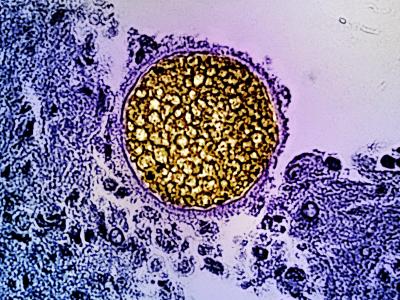Italy's chikungunya outbreak spreads to Rome; more cases noted in Americas
Italy has now confirmed 14 cases of locally acquired chikungunya, 6 of them in Rome, the World Health Organization (WHO) said in a Sep 15 statement.
The other 8 cases are in the coastal region of Lazio in Anzio district, about 30 miles south of Rome. Italian health officials on Sep 8 reported 3 locally acquired cases in Anzio, the first in the country since 2015. Dates of illness onset range from Aug 5 to Sep 7.
Officials have ramped up mosquito control efforts and halted blood transfusions in the affected region. Italy's Ministry of Health is communicating risks to the public and underscoring the need to protect against bites of the Aedes albopictus mosquito that transmits the disease.
Sep 15 WHO statement
In the Americas, meanwhile, the Pan American Health Organization (PAHO), in its weekly update late last week, reported 305 new cases as a handful of countries reported small increases.
The new cases lift the 2017 total in the region to 145,473, PAHO said in its Sep 15 update. The agency reported 617 new cases the week before.
Venezuela reported the largest increase, 143 new cases, to bring its total this year to 241. El Salvador, Guatemala, Nicaragua, Bolivia, Peru, and the United States all recorded small upticks. The US increase was only 8 cases, bringing its 2017 total to 46 infections, all of them imported cases.
Since the Americas outbreak began in 2013 on the Caribbean island of St. Martin, the Americas region has reported 2,532,184 cases.
Sep 15 PAHO update
US states, territories report 6 more babies born with Zika defects
In one of its latest updates on the impact of Zika virus, the US Centers for Disease Control and Prevention (CDC) said two more babies have been born in the United States with birth defects linked to the virus, raising the total to 95. The number of Zika-related pregnancy losses held steady at 8, according to the CDC's Sep 14 update.
Elsewhere, 4 more babies in the US territories have been born with Zika-related birth defects, pushing the total to 132. Seven pregnancy losses related to the virus have been reported in the territories, the same as in the CDC's previous update.
So far, 1,862 pregnant women with evidence of Zika infection have completed their pregnancies in US states with or without delivering a baby with birth defects. Meanwhile, in the US territories, 3,258 women infected with Zika virus have completed their pregnancies.
Sep 14 CDC update
H5N8 outbreaks continue in Italy and South Africa
More avian flu outbreaks fueled by highly pathogenic H5N8 were reported by animal health officials in Italy and South Africa, according to the latest notifications from the World Organization for Animal Health (OIE).
In Italy, the virus struck a goose farm in Veneto district in the north central part of the country. The outbreak began on Sep 11, killing 92 of 1,425 susceptible birds. The remaining birds were destroyed to curb the spread of the virus. Though H5N8 activity tailed off in most of Europe over the summer months, Italy continues to report a small but steady stream of outbreaks, especially involving turkey farms in the north.
Elsewhere, South Africa reported three more farm-related outbreaks and five more detections in other settings. The farm outbreaks all occurred in Western Cape Province, with start dates from Aug 15 to Aug 21. One of the locations is a commercial farm in Cape Town, the second-largest city in South Africa. One of the other outbreaks involved geese and chickens at a backyard holding. Among the three events, the virus killed 72 of 4,051 birds, while the others were slated for culling.
South Africa also reported five detections involving a variety of birds in other settings, all of them in Western Cape Province. The outbreaks—four in the city of Swartland and one in Bergrivier—started from Aug 26 to Sep 1, affecting show chickens, turkeys, and ducks, as well as hobby geese and chickens and a house sparrow found dead. Taken together, the virus killed 214 of 508 birds.
The country reported its first H5N8 outbreak in June, becoming the third African nation to report the virus.
Sep 15 OIE report on H5N8 in Italy
Sep 15 OIE report on H5N8 at South African farms
Sep 15 OIE report on H5N8 in other South African settings
Study shows co-circulating flu strains on Chinese pig farms
A new study published in Clinical Infectious Diseases determined multiple strains of 2009 H1N1, swine-lineage H1N1, and swine-lineage H3N2 co-circulated and likely reassorted among people and animals on six Chinese swine farms monitored for 1 year.
Researchers from Duke University and the Beijing Institute of Microbiology and Epidemiology used a One Health approach, which takes into account human, animal, and environmental health, to survey flu strains on 299 swine workers and 100 controls, 9,000 pigs, and 6 pig farm environments from 2015 to 2016. Study subject samples were collected monthly and tested for influenza A viruses (IAV).
Between March 2015 and February 2016, 4,884 samples were screened for IAVs. Flu strains were detected in 11.6% of environmental samples, 7.1% of swine oral secretions, and 4.8% of fecal samples. Five of the 32 humans who reported influenza-like illness during the study period had nasal swabs test positive for IAV.
According to the authors, "Sequencing results showed that swine-lineage H1N1 and H3N2, and A(H1N1)pdm09 –like viruses were detected in pig oral secretion and environmental swabs."
China is home to some of the largest swine farms in the world, and the country has been implicated as the origin of the 1957 and 1968 flu epidemics. The authors concluded that enhanced biosecurity is needed on swine farms.
Sep 16 Clin Infect Dis study
Microbes contribute to glacial melt
Multiplying microbes are increasing the rate of glacier melt on an Alaskan ice field, according to new data from a controlled field experiment recently published in Nature Geoscience. The snow-dwelling microbes increase the amount of light reflected on the ice's surface, leading to increased melting.
The study focused on microbes living on red snow algae. The presence of algae was positively related to an increasing amount of liquid water availability on the ice field. "The temporal correspondence of red snow, melt predictors, and melt rate are consistent with red-snow algae acting as both a cause and an effect of snowmelt," the authors write.
To offer a model of how red snow algae contributes to glacier melt, the authors documented how nitrogen–phosphorous–potassium fertilizer increased alga cell counts nearly fourfold, and that manipulating alga abundance explained a third of the observed variability in snowmelt.
The microbes "contribution to climate warming is likely to grow with increased melt and nutrient input," the authors concluded.
Sep 18 Nat Geosci study









